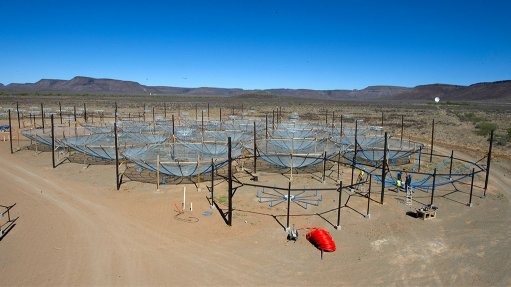
Hera antennas under construction. The workers to the right give scale
Photo by: SKA South Africa
The international Hydrogen Epoch of Reionisation Array (Hera) telescope, being constructed in South Africa’s radio astronomy reserve in the Northern Cape province, has received a significant new cash injection, that will fund a major expansion of the array, SKA South Africa (SKA SA) announced on Monday. SKA SA is one of the partners in the Hera programme.
The new grant is worth $5.8-million, and comes from the Gordon and Betty Moore Foundation. It follows a $9.5-million grant from the US National Science Foundation (NSF) in September last year. While the NSF grant ensures that Hera will have 240 antennas by 2018, this new grant will, in due course, increase that figure to 350. Construction of the array started in 2015 and so far 35 of the 14-m-diameter dishes have been erected.
Hera is intended to gather data from shortly after the birth of the universe, when the first stars, galaxies and black holes developed. The first generation of stars were hot and massive, and they and the first black holes flooded space with X-rays.
“Observations at the lowest radio frequencies (< 100 MHz), allow for observations of the epoch that precedes cosmic reinonisation where X-rays are expected to have heated the intergalactic medium,” explained SKA SA Hera senior astronomer Dr Gianni Bernardi. “As X-rays are expected to be generated by accretion on black holes, observations of this epoch will directly probe the properties of the first black holes formed in the universe.”
(Black holes are surrounded by accretion disks composed of gas, dust and other matter. These are accelerated to incredible speeds by the tremendous gravity of the black hole, with the result that they release heat, gamma rays and X-rays as the various particles of matter in the disks collide with each other. The epoch of reionisation started about 400-million years after the Big Bang. The universe is now about 13.77-billion years old.)
Hera is classified as a pathfinder for the SKA Phase 1 low frequency array (SKA1 LOW). Perhaps ironically, SKA1 LOW will be hosted by Australia, South Africa being the base for the SKA Phase 1 mid-frequency array. SKA stands for Square Kilometre Array and will be the world’s biggest radio telescope.
In addition to SKA SA, the partners in Hera are, in the US, the National Radio Astronomy Observatory, Arizona State University, Brown University, the Massachusetts Institute of Technology, the University of California at Berkeley, the University of California at Los Angeles, the University of Pennsylvania and the University of Washington. In Italy, the partner institution is the Scuola Normale Superiore of Pisa, and in the UK, Cambridge University. South African universities associated with the programme are KwaZulu-Natal, Rhodes, Western Cape, and Witwatersrand.